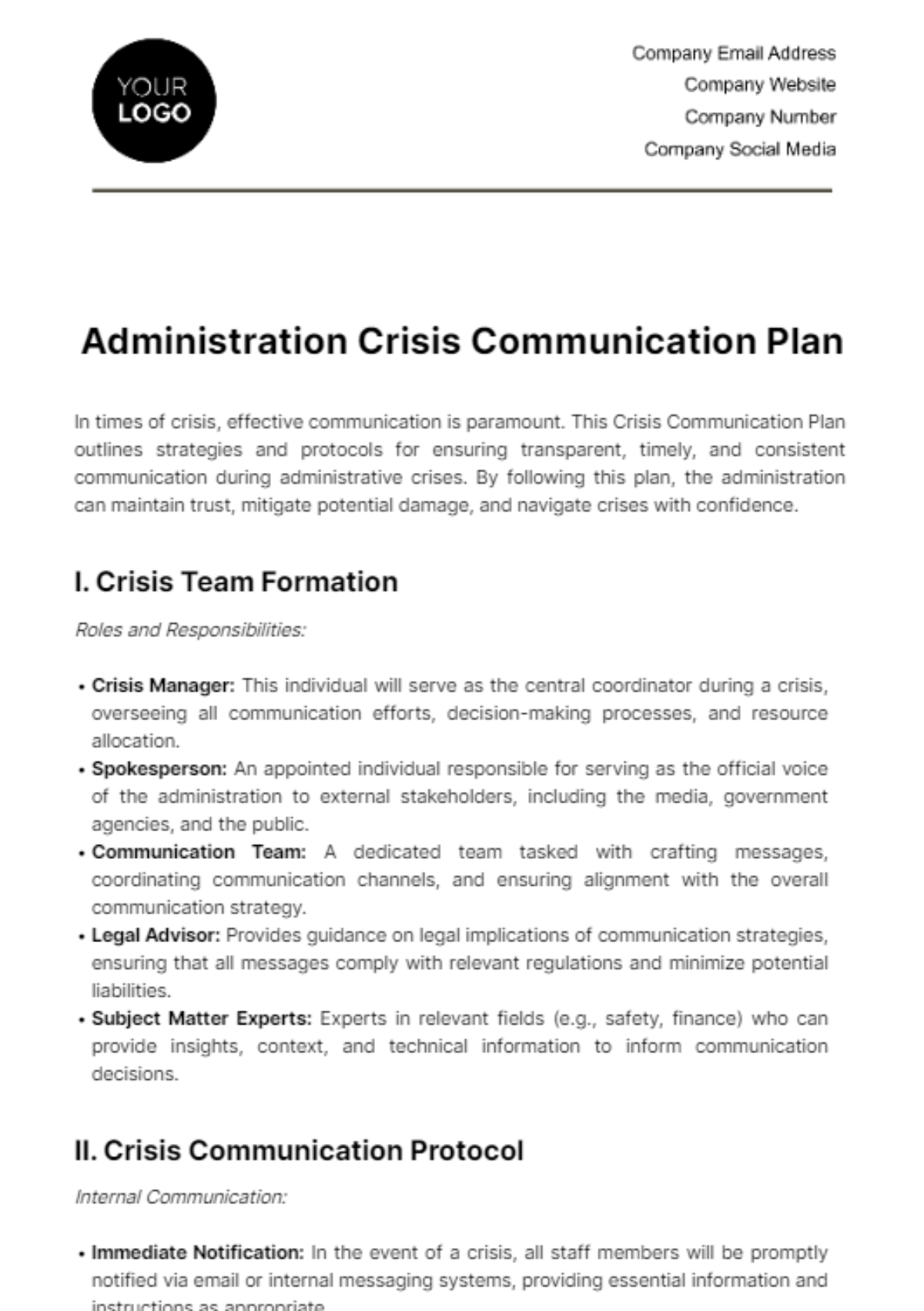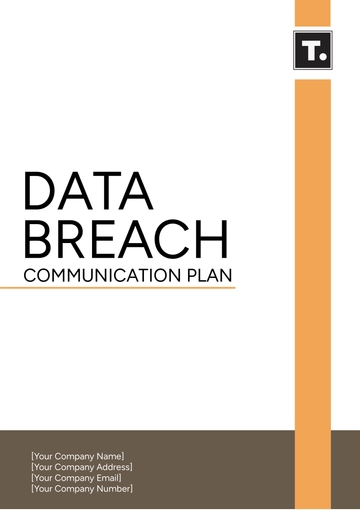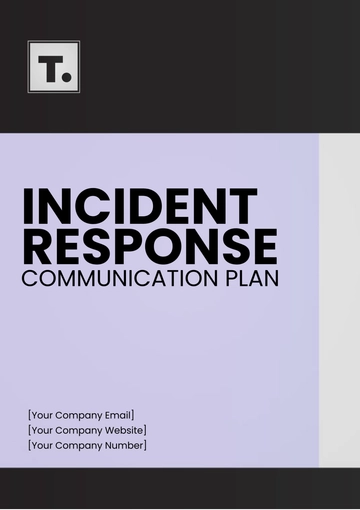Free Administration Crisis Communication Plan

In times of crisis, effective communication is paramount. This Crisis Communication Plan outlines strategies and protocols for ensuring transparent, timely, and consistent communication during administrative crises. By following this plan, the administration can maintain trust, mitigate potential damage, and navigate crises with confidence.
I. Crisis Team Formation
Roles and Responsibilities:
Crisis Manager: This individual will serve as the central coordinator during a crisis, overseeing all communication efforts, decision-making processes, and resource allocation.
Spokesperson: An appointed individual responsible for serving as the official voice of the administration to external stakeholders, including the media, government agencies, and the public.
Communication Team: A dedicated team tasked with crafting messages, coordinating communication channels, and ensuring alignment with the overall communication strategy.
Legal Advisor: Provides guidance on legal implications of communication strategies, ensuring that all messages comply with relevant regulations and minimize potential liabilities.
Subject Matter Experts: Experts in relevant fields (e.g., safety, finance) who can provide insights, context, and technical information to inform communication decisions.
II. Crisis Communication Protocol
Internal Communication:
Immediate Notification: In the event of a crisis, all staff members will be promptly notified via email or internal messaging systems, providing essential information and instructions as appropriate.
Regular Updates: Continuous updates will be provided to all staff members through various internal communication channels, such as email, intranet announcements, and staff meetings, to keep them informed of developments and actions taken by the administration.
Designated Point of Contact: A designated individual or team will be established to address staff inquiries, concerns, and feedback throughout the crisis period, ensuring a direct line of communication and support.
External Communication:
Centralized Spokesperson: The appointed spokesperson will serve as the primary point of contact for all external communication, including media inquiries, public statements, and stakeholder engagements, to maintain consistency and coherence in messaging.
Multichannel Distribution: Information will be disseminated externally through various channels, including press releases, official statements, social media updates, and the administration's website, to reach diverse audiences and stakeholders effectively.
Stakeholder Engagement: Clear communication channels will be established to facilitate direct communication with key stakeholders, such as investors, clients, partners, and community members, enabling timely updates and addressing concerns.
III. Message Development
Key Messages:
Acknowledgment of the Crisis: Express sincere acknowledgment of the crisis situation, demonstrating empathy and understanding of the challenges faced by those affected.
Steps Being Taken: Communicate transparently about the actions being taken by the administration to address the crisis, including mitigation efforts, resource allocation, and collaboration with relevant stakeholders.
Assurance of Ongoing Updates: Provide reassurance to stakeholders that the administration is committed to providing regular updates and information as the situation evolves, maintaining transparency and accountability.
Empathy and Concern: Convey genuine empathy and concern for the well-being of those impacted by the crisis, expressing support, solidarity, and a commitment to addressing their needs and concerns.
Consistency and Accuracy:
Message Alignment: Ensure consistency and alignment in messaging across all communication channels, avoiding contradictions or discrepancies that may undermine credibility or confuse stakeholders.
Fact-Checking and Verification: Conduct thorough fact-checking and verification of information before dissemination to ensure accuracy, reliability, and credibility, minimizing the risk of spreading misinformation or rumors.
Avoid Speculation: Refrain from speculating or providing unconfirmed information that could exacerbate panic, confusion, or misinformation, adhering to a principle of transparency and evidence-based communication.
IV. Media Relations
Media Contact Strategy:
Single Point of Contact: Designate a specific individual or team as the primary point of contact for all media inquiries, ensuring efficient and consistent handling of requests, inquiries, and interviews.
Media Kit Preparation: Develop a comprehensive media kit containing background information, key facts, official statements, and relevant resources to facilitate media coverage and ensure accuracy in reporting.
Preparedness for Interviews: Conduct media training sessions for designated spokespersons and crisis team members to prepare them for interviews, press conferences, and media interactions, enhancing their confidence and effectiveness in communicating the administration's message.
Press Conferences and Interviews:
Logistical Coordination: Plan and coordinate press conferences, interviews, and media engagements in advance, ensuring appropriate venues, equipment, and logistical support to facilitate effective communication and media coverage.
Message Consistency: Ensure consistency in messaging and communication points across all press conferences, interviews, and media interactions, avoiding contradictions or inconsistencies that may undermine credibility or confuse stakeholders.
Media Monitoring and Response: Monitor media coverage and public sentiment closely, promptly responding to inaccuracies, misconceptions, or negative coverage through proactive media engagement, corrections, or clarifications as needed.
V. Monitoring and Evaluation
Feedback Mechanisms:
Stakeholder Feedback: Solicit feedback from stakeholders, including staff members, clients, partners, and community members, through surveys, focus groups, or direct communication channels to assess the effectiveness of communication efforts and identify areas for improvement.
Media Monitoring: Monitor media coverage, social media conversations, and online discussions related to the crisis to gauge public sentiment, identify emerging issues, and track the impact of communication strategies on perception and reputation.
Performance Metrics: Establish key performance indicators (KPIs) and metrics to measure the impact, reach, and effectiveness of communication efforts, such as audience engagement, message penetration, sentiment analysis, and crisis response time.
Post-Crisis Review:
Comprehensive Evaluation: Conduct a comprehensive review and analysis of the crisis communication response, including strengths, weaknesses, successes, and areas for improvement, involving all relevant stakeholders and departments to ensure a holistic assessment.
Lessons Learned: Identify and document key lessons learned from the crisis communication experience, capturing best practices, insights, and recommendations for enhancing future crisis preparedness, response, and communication strategies.
Plan Revision: Update and revise the Crisis Communication Plan based on the findings and recommendations from the post-crisis review, incorporating lessons learned, new insights, emerging trends, and changes in the regulatory or operational environment to strengthen resilience and readiness for future crises.
VI. Conclusion
Crisis communication is an ongoing process that requires continuous monitoring, evaluation, and adaptation to evolving challenges, risks, and stakeholder expectations, fostering a culture of resilience, responsiveness, and transparency within the administration.
By adhering to this Crisis Communication Plan and embracing a proactive, transparent, and strategic approach to communication, the administration can enhance its resilience, credibility, and trustworthiness, even in the face of adversity, safeguarding its reputation and relationships with stakeholders.
- 100% Customizable, free editor
- Access 1 Million+ Templates, photo’s & graphics
- Download or share as a template
- Click and replace photos, graphics, text, backgrounds
- Resize, crop, AI write & more
- Access advanced editor
Presenting Template.net's Administration Crisis Communication Plan Template. Easily editable and customizable, this template offers a comprehensive solution for managing crises effectively. Crafted for clarity and precision, it's editable in our AI Editor Tool, empowering you to tailor communication strategies seamlessly. Streamline crisis response with confidence and efficiency.





























